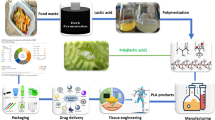Abstract
Biodegradable poly(ε-caprolactone) (PCL) was successfully synthesized by the green polymerization process that was conducted in the absence of heavy metal catalyst and toxic solvent. L-Lactic (LLA) and glycolic acids (GA) were utilized as green initiator for the bulk ring-opening polymerization (ROP) of ε-caprolactone (ε-CL). These organic initiators could produce PCL with number average molecular weight (Mn) in the range of 8.46 × 103–1.98 × 104 g/mol and molecular weight distribution (MWD) of 1.71–1.81. GA could produce higher molecular weight PCL than LLA under identical synthesis condition. The catalytic performance of these initiators in the ROP of ε-CL was completely investigated by the non-isothermal differential scanning calorimetry (DSC). From non-isothermal DSC kinetics analysis, the reactivity of GA was higher than LLA in the bulk ROP of ε-CL as supported by the lower values of activation energy (Ea) and frequency factor (A) of GA than LLA initiator. The polymerization mechanism for the ROP of ε-CL initiated by LLA and GA was proposed through the activated monomer mechanism.
Graphic abstract








Similar content being viewed by others
References
Dove AP (2012) Organic catalysis for ring-opening polymerization. ACS Macro Lett 1(12):1409–1412
Albertsson AC, Varma IK (2003) Recent developments in ring opening polymerization of lactones for biomedical applications. Biomacromol 4(6):1466–1486
Stridsberg KM, Ryner M, Albertsson AC (2002) Controlled ring-opening polymerization: polymers with designed macromolecular architecture. Adv Polym Sci 157:41–65
Stjerndahl A, Wistrand AF, Albertsson AC (2007) Industrial utilization of tin-initiated resorbable polymers: synthesis on a large scale with a low amount of initiator residue. Biomacromol 8(3):937–940
Connor EF, Nyce GW, Myers M, Mock A, Hedrick JL (2002) First example of N-heterocyclic carbenes as catalysts for living polymerization: organocatalytic ring-opening polymerization of cyclic esters. J Am Chem Soc 124(6):914–920
Dove AP, Pratt RC, Lohmeijer BGG, Culkin DA, Hagberg EC, Nyce GW, Waymouth RM, Hedrick JL (2006) N-heterocyclic carbenes: effective organic catalysts for living polymerization. Polymer 47(11):4018–4020
Lohmeijer BGG, Pratt RC, Leibfarth F, Logan JW, Long DA, Dove AP, Nederberg F, Choi J, Wade C, Waymoth RM, Hedrick JL (2006) Guanidine and amidine organocatalysts for ring-opening polymerization of cyclic esters. Macromolecules 39(25):8574–8583
Coady DJ, Fukushima K, Horn HW, Rice JE, Hedrick JL (2011) Catalytic insights into acid/base conjugates: highly selective bifunctional catalysts for the ring-opening polymerization of lactide. Chem Comm 47(11):3105–3107
Labet M, Thielemans W (2012) Citric acid as a benign alternative to metal catalysts for the production of cellulose-grafted-polycaprolactone copolymers. Polym Chem 3(3):679–684
Wang H, Wu W, Li Z, Zhi X, Chen C, Zhao C, Li X, Zhang Q, Guo K (2014) 2,4-Dinitrobenzenesulfonic acid in an efficient Brønsted acid-catalyzed controlled/living ring-opening polymerization of ε-caprolactone. RSC ADV 4:55716–55722
Oledzka E, Sokolowski K, Sobczak M, Kolodziejski W (2011) Amino acids as initiators of caprolactone and L,L-lactide polymerization. Polym Int 60:787–793
Liu J, Liu L (2004) Ring-opening polymerization of ε-caprolactone initiated by natural amino acids. Macromolecules 37:674–2676
Yu ZJ, Liu LJ, Zhou RX (2003) Microwave-improved polymerization of ε-caprolactone initiated by carboxylic acids. J Polym Sci A Polym Chem 41:13–21
Song Y, Liu Y, Weng X, Zhou R (2004) Acid-initiated polymerization of epsilon-caprolactone under microwave irradiation and its application in the preparation of drug controlled release system. J Biomater Sci Polym Ed 14:241–253
Xu J, Song J, Pispas S, Zhang G (2014) Controlled/living ring-opening polymerization of caprolactone with salicylic acid as the organocatalyst. J Polym Sci A Polym Chem 52:1185–1192
Ciccone WJ, Motz C, Bentley C, Tasto JP (2001) Bioabsorbable implants in orthopedics: new developments and clinical applications. J Am Acad Orthop Surg 9:280–288
Gregory GL, Lopez-Vidal EM, Buchard A (2017) Polymers from sugars: cyclic monomer synthesis, ring-opening polymerisation, material properties and applications. Chem Commun 53(14):2198–2217
Nachtergael A, Coulembier O, Dubois P, Helvenstein M, Duez P, Blankert B, Mespouille L (2015) Organocatalysis paradigm revisited: are metal-free catalysts really harmless? Biomacromol 16:507–514
Gvili K, Benny O, Danino D, Machluf M (2007) Poly(D,L-lactide-co-glycolide acid) nanoparticles for DNA delivery: waiving preparation complexity and increasing efficiency. Biopolymers 85:379–391
Li SM, Garreau H, Vert M (1990) Strcuture-property relationships in the case of the degradation of massive poly(±-hydroxy acids) in aqueous media, part 1L poly(DL-lactic acid). J Mater Sci Mater Med 1:123–130
Limwanich W, Meepowpan P, Punyodom W (2020) Influence of butyl group of tin chloride initiators on the non-isothermal DSC ring-opening polymerization of ε-caprolactone: the studies of kinetics, mechanism and polymer synthesis. Thermochim Acta 683:178458
Hernandez AR, Richa AM (2010) Ring opening polymerization of ε-caprolactone initiated by decamolybdate anion: determination of kinetic and thermodynamic parameters by DSC and 1H-NMR. J App Polym Sci 115:288–2295
Limwanich W, Meepowpan P, Nalampang K, Kungwan N, Molloy R, Punyodom W (2015) Kinetics and thermodynamics analysis for ring-opening polymerization of ε-caprolactone initiated by tributyltin n-butoxide using differential scanning calorimetry. J Therm Anal Calorim 119:567–579
Kissinger HE (1957) Reaction kinetics in differential thermal analysis. Anal Chem 29:1702–1706
Starink MJ (2003) The determination of activation energy from linear heating rate experiments: a comparison of the accuracy of isoconversion methods. Thermochim Acta 404:163–176
Vyazovkin S, Burnham AK, Criado JM, Perez-Maqueda LA, Popescu C, Sbirrzaauoli N (2011) ICTAC kinetics committee recommendations for performing kinetic computations on thermal analysis data. Thermochim Acta 520:1–19
Acknowledgements
The authors wish to thanks the financial supports from Chiang Mai University (WP, PM), the Thailand Research Fund (TRF) (MRG6080164) (WL) and Office of the Higher Education Commission (OHEC) (WL). The Department of Chemistry and Materials Science Research Center, Faculty of Science, Chiang Mai University (CMU) and Faculty of Sciences and Agricultural Technology, Rajamangala University of Technology Lanna (RMUTL) are also acknowledged.
Author information
Authors and Affiliations
Corresponding author
Additional information
Publisher's Note
Springer Nature remains neutral with regard to jurisdictional claims in published maps and institutional affiliations.
Rights and permissions
About this article
Cite this article
Limwanich, W., Meepowpan, P., Sriyai, M. et al. Eco-friendly synthesis of biodegradable poly(ε-caprolactone) using L-lactic and glycolic acids as organic initiator. Polym. Bull. 78, 7089–7101 (2021). https://doi.org/10.1007/s00289-020-03401-2
Received:
Revised:
Accepted:
Published:
Issue Date:
DOI: https://doi.org/10.1007/s00289-020-03401-2




